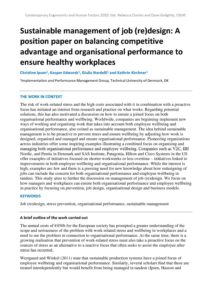| Document | Author Christine Ipsen, Kasper Edwards, Giulia Nardelli and Kathrin Kirchner |
| Abstract The risk of work-related stress and the high costs associated with it in combination with a proactive focus has initiated an interest from research and practice on what works. Regarding potential solutions, this has also motivated a discussion on how to ensure a joined focus on both organisational performance and wellbeing. Worldwide, companies are beginning implement new ways of working and organising work that takes into account both employee wellbeing and organisational performance, also coined as sustainable management. The idea behind sustainable management is to be proactive to prevent stress and ensure wellbeing by adjusting how work is designed, organised and managed and ensure organisational performance. Pioneering organisations across industries offer some inspiring examples illustrating a combined focus on organising and managing both organisational performance and employee wellbeing. Companies such as V2C, IIH Nordic, and Pentia in Denmark and SAS Institute, Patagonia, Hilton and Cisco Systems in the US offer examples of initiatives focused on shorter workweeks or less overtime – initiatives linked to improvements in both employee wellbeing and organisational performance. While the interest is high, examples are few and there is a pressing need for new knowledge about how redesigning of jobs can include the concern for both organisational performance and employee wellbeing in tandem. This study aims to further the discussion on management of job (re)design. We focus on how managers and workplaces can ensure both organisational performance and employee wellbeing in practice by focusing on prevention, job design, organisational design and business models. |

